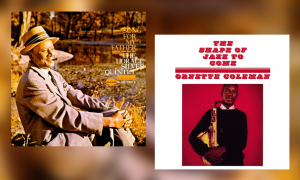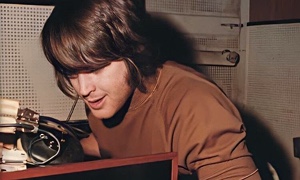Home » Jazz Articles » Building a Jazz Library » Chet Baker: An Alternative Top Ten Albums To Get Lost In
Chet Baker: An Alternative Top Ten Albums To Get Lost In

Courtesy Michiel Hendryckx
You do not generally feel like jumping up and shouting ‘Yeah!’ after a Chet Baker trumpet solo. All that tenderness, turmoil and pain has driven you too far inside. He reaches that same part of us as a late Beethoven string quartet, a spiritual hole where music becomes religion.
—Mike Zwerin
Baker's breakthrough came in summer 1952. In short order, he was taken under the approving wing of alto saxophonist Charlie Parker, who was performing at LA's Tiffany Club, and began working with baritone saxophonist Gerry Mulligan's historic pianoless quartet. "The pianist didn't turn up to rehearsal one day," Baker said years later, "and we decided it sounded better that way." (Mulligan told a different story).
Baker's natural-born talent as a trumpeter was accompanied by movie-star looks. He was as good looking as James Dean and enviably photogenic. In Bruce Weber's flawed but fascinating 1988 documentary Let's Get Lost, trumpeter Jack Sheldon observes how hard it was to hang on to a sexual partner if Baker was in the vicinity—even, Sheldon deadpans, if you were actually having sex with the person in question at the time.
As the years passed, heroin took its toll on Baker's looks. After smoking industrial quantities of weed since the late 1940s, he acquired a serious heroin habit in the mid 1950s. The drug dominated his life until he passed, after falling out of a third-floor hotel window in Amsterdam in 1988. In an interview for Matthew Ruddick's (definitive) biography Funny Valentine: The Story Of Chet Baker (Melrose, 2012), bassist Ron McClure says that towards the end Baker "looked like twenty miles of bad road." But his personal magnetism was undimmed.
Baker's good looks undoubtedly bolstered his career, especially as a singer. On the basis of his first vocal album, Chet Baker Sings (Pacific Jazz, 1954), he tied Nat King Cole for third place in the Down Beat poll. There are only a handful of vocal tracks spread across the mainly instrumental Alternative Top Ten Albums listed below, though that was not a consideration when selecting the albums.
Heroin dominated Baker's life to such an extent that it is hard to avoid it when writing about his music: the intensity of his addiction, and that of many of the musicians he worked with, influenced the music and the circumstances in which it was recorded. Despite it all, on a good night Baker was still playing great jazz right up until the end. He himself felt his work in the 1970s and 1980s reached new degrees of beauty and profundity, and you may agree with him.
Most Baker connoisseurs' Essential Top Tens start with Gerry Mulligan Quartet: The Original Quartet With Chet Baker (Pacific Jazz, recorded 1952-53, compiled 1998) and will likely include some or all of the following: The Best Of Chet Baker Sings (Pacific Jazz, 1953-56, compiled 1989); In Paris: A Selection Of The Legendary Barclay Sessions 1955-1956 (EmArcy, 2000), or the multi-disc complete works if you can run to it; Jim Hall's Concierto (CTI, 1975); Once Upon A Summertime (Artists House, 1980); Blues For A Reason (Criss Cross, 1985); Diane (Steeplechase, 1985); Chet's Choice (Criss Cross, 1985); Live From The Moonlight (Philology, 1988); and Chet Baker In Tokyo (Enja, 1988), the greatest live album he ever recorded.
This Alternative Top Ten focuses on less widely celebrated but outstanding releases. Hopefully you will find one or two items with which you are not yet familiar.
CHET BAKER: TEN IRRESISTIBLE VALENTINES
 Chet Baker Quartet
Chet Baker Quartet Chet Baker Quartet Featuring Russ Freeman
Pacific Jazz, 1953
This was Baker's own-name debut album following his breakthrough with the Gerry Mulligan Quartet. Originally an eight-track 10" LP, in 1998 Pacific reissued the tracks on a compilation CD with the same title. The 25 tracks are a mixture of Great American Songbook standards and originals written by the pianist and composer Russ Freeman. The rolling cast of bassists and drummers are mostly Mulligan quartet alumni: bassists Joe Mondragon, Bobby Whitlock and Carson Smith, and drummers Larry Bunker, Bobby White and Shelly Manne.
Baker plays with seraphic beauty throughout. Highlights include Gershwin's "Long Ago And Far Away," Burke and Van Heusen's "Imagination" and the Freeman originals "Batter Up," "No Ties" and "Bea's Flat," the last of which includes a particularly sparkling solo.
The companion compilation Gerry Mulligan Quartet: The Original Quartet With Chet Baker is more widely celebrated than Chet Baker Quartet Featuring Russ Freeman. But both deserve a place in your collection.
 Chet Baker
Chet Baker Chet Baker & Crew
Pacific Jazz, 1956
Chet Baker & Crew is the first album Baker recorded in the US following his return from an eighteen-month 1955-56 European tour on which he had been playing with a band which included the precociously talented young American pianist Dick Twardzik.
In Europe, Baker acquired his first full-blown heroin habit (and Twardzik died of an overdose). Most of the band on Chet Baker & Crew were users, too. So the vibe of ocean-breeze wholesomeness suggested by the sleeve photo is misleading. The shot is true to the vitality of the music, however, which is played by a sextet which includes tenor saxophonist Phil Urso, pianist Bobby Timmons and Peter Lippman on drums. Standout tracks include Al Cohn's "Something For Liza" and Gerry Mulligan's "Revelations."
It is tempting to speculate as to whether the cover of Chet Baker & Crew influenced the art direction Columbia followed for the sleeve of the first pressing of Miles Davis' Miles Ahead two years later, which showed a glamorous white model on an ocean-going yacht. We shall probably never know (but the world will keep on turning).
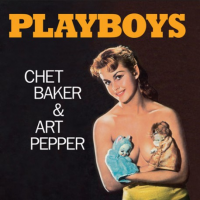 Chet Baker & Art Pepper
Chet Baker & Art Pepper Playboys
Pacific Jazz, 1957
And while we are on the subject of cover designs... Playboys' sleeve was par for the course in the 1950s. However, the album was quickly retitled Picture Of Heath, after its chief composer and arranger, tenor saxophonist Jimmy Heath—because Hugh Hefner, publisher of Playboy magazine, threatened to sue for trademark infringement—and the sleeve photo was replaced by one of the band. In 1990 Pacific Jazz reissued the album on CD with the original sleeve, an edition which will appeal to fans of glove puppets.
Heath's uncluttered arrangements are excellent launching pads for soloists and the three horns—Baker, Pepper and Phil Urso—respond with fiery, extrovert solos, driven along by pianist Carl Perkins, bassist Curtis Counce and drummer Larance Marable. There are five Heath originals, including "For Minors Only," "Picture Of Heath" and "C.T.A.," (all three of which Heath recorded on his 1975 Xanadu album, which was also called Picture Of Heath). The other two tracks are Pepper originals.
In Jeroen De Valk's Chet Baker: His Life And Music (Berkeley Hills, 2000), Heath memorably describes the album as "an authentic junkie record." Pepper was just out of jail, Baker was arrested a week after the session, Urso was still strung out and Perkins would die two years later. When the record was recorded, Heath himself was behind bars for possession. Pacific Jazz's Dick Bock had to come and fetch the sheet music from jail.
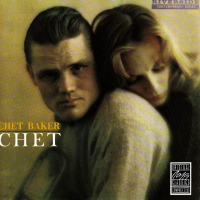 Chet Baker
Chet Baker Chet
Riverside, 1959
Despite all the grief Baker put record label executives (and club owners) through with his serial requests for cash, most of the people he dealt with had an abiding affection for him—partly because of his artistry, partly because of his charm and vulnerability. Riverside's Orrin Keepnews, however, was an exception. He detested Baker.
Baker was signed to Riverside by Keepnews' business partner, Bill Grauer, who saw dollar signs when he heard Baker sing. In his liner notes for a posthumous reissue of Chet, Keepnews says he did not like Baker's singing but felt obliged to go along with Grauer's wishes. "Before long," Keepnews continued, "[Baker] had achieved the distinction of forcing me to switch my home phone to an unlisted number" in order to avoid small-hours phone calls begging for immediate cash. Baker was one night caught trying to break into Riverside's stockroom, from which he planned to lift boxfuls of Chet, to autograph and sell at gigs. On another occasion, he stole blank cheques from Keepnews' office and tried to cash them at local pharmacies.
But even Keepnews felt that (the all-instrumental) Chet was a great album. Baker plays beautifully as do Riverside's rising-star pianist Bill Evans, baritone saxophonist Pepper Adams, flautist Herbie Mann, guitarist Kenny Burrell, bassist Paul Chambers and alternating drummers Connie Kay and Philly Joe Jones. With a set list composed entirely of Great American Songbook classics, Chet is a late-night album on a par with Burrell's own Midnight Blue (Blue Note, 1963).
 Terry Riley
Terry Riley Music For The Gift
Cortical Foundation, 2000
Every record collection should contain some curiosities. Here is one. Recorded between 1961 and 1965 in Paris and California, but not released until 2000, Music For The Gift is a Terry Riley album rather than a Baker one. But fans of the trumpeter will enjoy hearing his (looped and electronically manipulated) contributions to this work by the minimalist pioneer in the years leading up to his first masterpiece, In C (Columbia, 1968).
Music For The Gift was intended to be the soundtrack for an avant-garde stage play. Baker is heard, albeit unrecognisably, on half of the tracks, which were recorded in Paris in 1963. In her memoir Born Under The Sign Of Jazz (Sanctuary, 1998), the Norwegian jazz advocate Randi Hultin, who began a lifelong friendship with Baker in Paris in 1963, says he also acted and played trumpet in The Gift during its two week run at the city's Recamier Theatre that year. Whether this was before or after the recording of Riley's soundtrack, Hultin does not say.
In any event, Baker's sound was a great fit for Riley's music and he might have been asked to play on the In C session had he not at the time been rebuilding his embrochure following a savage street brawl (which necessitated dentures) in San Francisco in 1966 (in the event, Jon Hassell was the trumpeter).
And still with "what if" history... When speaking about his tape-manipulated productions for Miles Davis, Teo Macero readily acknowledged a debt to Terry Riley. It is easy to detect the genesis of Macero's work in Music For The Gift. Who knows what might have arisen had Baker been the trumpeter on In A Silent Way. Magic would certainly have been on the cards.
 Chet Baker
Chet Baker She Was Too Good To Me
CTI, 1974
Creed Taylor's CTI billed She Was Too Good To Me as a comeback album. It followed one of Baker's lengthy descents into out-of-control heroin use, which was compounded by the battle to rebuild his embrochure referred to above. Concerned about Baker's chops, Taylor surrounded him with reliable session musicians and cushioned him on some tracks with a string section. The backings are saccharine at times but Baker himself is clearly on the road to recovery and near to his lyrical best.
Incidentally, dental problems are also the reason Baker is only ever shown giving a tight-lipped half-smile in the image-building photos William Claxton shot of him during the early 1950s: Baker had already lost one front tooth. In his book Young Chet (Te Neues, 1993), Claxton says: "As long as I knew Chet he had one missing tooth in the front that made him look charming and dopey at the same time. And [he made sure that] the missing tooth never showed up in any of his pictures." (Baker let his guard down in a fan photograph taken backstage at a Los Angeles club in 1953. He is shown standing next to Miles Davis and is so thrilled to be in the presence of his hero that he is grinning broadly).
Seven of the eight tracks on She Was Too Good To Me are from the Great American Songbook, with "Autumn Leaves" and "Tangerine" especially memorable. Alto saxophonist Paul Desmond turns in lovely solos, and flautist Hubert Laws, who was all too capable of inconsequential fusion, raises his game on Hank Mobley's "Funk In Deep Freeze."
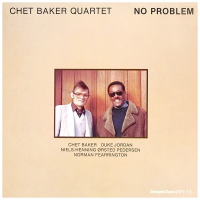 Chet Baker Quartet
Chet Baker QuartetNo Problem
Steeplechase, 1980
Baker spent a large part of his career in Europe, where he recorded a slew of below-par albums for more or less dodgy labels in return for off-the-books cash payments. Among the more rewarding liaisons was one with Denmark's Steeplechase. Baker's most successful albums for the label include The Touch Of Your Lips (1979), made with a drummerless trio which includes guitarist Doug Raney and bassist Niels-Henning Orsted Pedersen, and Diane (1985), a duo set with pianist Paul Bley.
And No Problem makes three. Pedersen is again present, in a quartet which also includes pianist Duke Jordan, who wrote all the tunes, and drummer Norman Fearrington. Jordan's melodic but bittersweet style is a perfect fit. Baker rarely used a mute—he feared that people would accuse him of mimicking Miles Davis—but he uses one to captivating effect on several tracks here. On "Kiss Of Spain" Baker does, indeed, sound rather like early Davis. Who cares?
Steeplechase was well distributed throughout Europe and also in the US, where the label did much to raise his profile, which had declined since the mid 1970s. Steeplechase boss and producer Nils Winther was a genuine admirer of Baker's work and took pains to record him in the good studios and with congenial sidemen—and the love shines through.
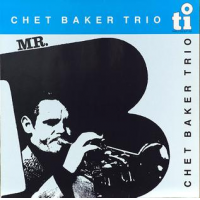 Chet Baker Trio
Chet Baker TrioMr. B
Timeless, 1984
By 1983, when Mr. B was recorded, Baker was regularly working with drummerless lineups. On Mr. B, he leads a trio with pianist Michel Graillier and bassist Riccardo Del Fra. The set focuses on jazz material—Herbie Hancock's "Dolphin Dance," Horace Silver's "Strollin,'" Charlie Haden's "Ellen And David," Dave Brubeck's "In Your Own Sweet Way" and Sam Rivers' "Beatrice." The title track was written by pianist Hal Galper, who regularly performed with Baker.
The trio had been playing the tunes live for some time and they benefit from being well worn in. Baker's solo on "Beatrice" is sublime. "Dolphin Dance" is another delight. The quality of Baker's performances on the album is all the more remarkable considering the depths of heroin addiction he had fallen into in 1982, following a few years of relatively moderate use.
Like Steeplechase's Nils Winther, Timeless' Wim Wight—a Dutch promoter who had been booking European dates for Baker since 1976—was a longtime fan. So, again like Winther, Wight tried to do right by his artist. During the Mr. B session, Baker was suffering from a nagging cough, which broke out whenever he stopped playing: Wight had the engineer painstakingly go through the finished tapes deleting the many noises off.
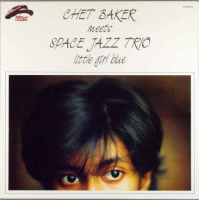 Chet Baker Meets Space Jazz Trio
Chet Baker Meets Space Jazz Trio Little Girl Blue
Philology, 1988
Given the many visits Baker made to Italy, it is perhaps surprising that he never recorded an unalloyed stonker with the pianist Enrico Pieranunzi. The pair recorded together several times during the 1980s and the results never quite come up to expectations. Little Girl Blue, however, just about scrapes four stars.
The day before the session, Baker and Pieranunzi had recorded the lacklustre duo album The Heart Of The Ballad (Philology, 1988), on which Baker sounds tired and frail. But in a pattern that repeated itself throughout his career, something had obviously come along to improve Baker's mood by the time he returned to the studio. Pieranunzi's trio is completed by bassist Enzo Pietropaoli and drummer Fabrizio Sferra.
The set list comprises two jazz standards: Wayne Shorter's "House Of Jade" and Miles Davis and Bill Evans' "Blue In Green," which Baker takes at a breathtakingly effective slow pace. There are four standards: Harold Arlen's "Come Rain Or Come Shine," Burton Lane's "Old Devil Moon," Cole Porter's "Just One Of Those Things" and Burton Lane and Yip Harburg's title track, to which Baker adds a dreamy vocal.
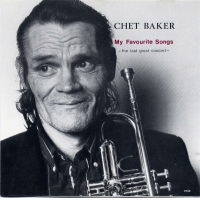 Chet Baker
Chet Baker My Favourite Songs: The Last Great Concert
Enja, 1988
My Favourite Songs: The Last Great Concert is a collection of small group, big band and orchestral tracks recorded in Germany with the NDR Big Band, Radio Orchestra Hannover and guests one evening in late April 1988. After a tentative start, Baker, who had missed two days of planned rehearsals, but memorised the arrangements a few hours before showtime, hits form on seven jazz standards and Great American Songbook classics: Miles Davis' "All Blues," Richard Rodgers' "My Funny Valentine" (one of two tracks on which Baker sings as well as plays trumpet), Thelonious Monk's "Well You Needn't," Dave Brubeck's "In Your Own Sweet Way," John Lewis' "Django," Jule Styne and Sammy Cahn's "I Fall In Love Too Easily" and George Gershwin's "Summertime." Two weeks later, Baker passed.
Let us finish as we began, with a quote from trombonist, writer and longtime Baker fan Mike Zwerin's Close Enough For Jazz (Quartet, 1983)...
"[Baker] always plays seated, folded into a question-mark. Between solos, he sits, trumpet resting on his crossed legs, without moving. You almost say to yourself—my God, he's passed away up there. Then, ever so slowly, he raises the instrument to his lips and when those sweetly burned innocent notes bloom again it's a relief, almost as though you've made it through one more winter. Chet Baker is summertime, but the livin' isn't easy."
Tags
PREVIOUS / NEXT
Support All About Jazz
 All About Jazz has been a pillar of jazz since 1995, championing it as an art form and, more importantly, supporting the musicians who make it. Our enduring commitment has made "AAJ" one of the most culturally important websites of its kind, read by hundreds of thousands of fans, musicians and industry figures every month.
All About Jazz has been a pillar of jazz since 1995, championing it as an art form and, more importantly, supporting the musicians who make it. Our enduring commitment has made "AAJ" one of the most culturally important websites of its kind, read by hundreds of thousands of fans, musicians and industry figures every month.










